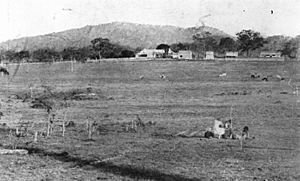Raspberry Creek Homestead facts for kids
Quick facts for kids Raspberry Creek Homestead |
|
|---|---|

Raspberry Creek Homestead, 2009
|
|
| Location | 2312 Byfield Road, Byfield, Shire of Livingstone, Queensland, Australia |
| Design period | 1840s - 1860s (mid-19th century) |
| Built | circa 1860s |
| Official name: Raspberry Creek Homestead | |
| Type | state heritage (built) |
| Designated | 21 October 1992 |
| Reference no. | 600658 |
| Significant period | 1860s circa - ongoing (social) |
| Significant components | residential accommodation - main house |
| Lua error in Module:Location_map at line 420: attempt to index field 'wikibase' (a nil value). | |
Raspberry Creek Homestead is a historic pioneer home, now a museum, located in Byfield, Australia. A homestead is the main house and buildings on a large farm or station. This one was built around the 1860s by one of the first European families to settle in the area. Because of its importance, it was added to the Queensland Heritage Register on 21 October 1992. This means it is protected as a special historical site.
Contents
History of the Homestead
The story of Raspberry Creek Homestead begins with James and Mary Hutton. They were pioneers in the Shoalwater Bay area of Central Queensland. A pioneer is one of the first people to live and work in a new area.
The Hutton Family's Journey
James Hutton's family came to Australia from Ireland in 1841. Mary Cameron's family arrived from Scotland in 1849. Both families settled in the New England region of New South Wales. James and Mary got married there in 1852.
In 1863, James and Mary decided to move their family to Central Queensland. They traveled for six months to reach the Raspberry Creek area, north of Rockhampton. They brought everything they owned on two wagons called buckboards and also herded a few hundred cattle.
When they arrived, they first built simple huts made of bark and wood slabs. A few years later, they built the main homestead that still exists today. They used timber that they cut and sawed themselves.
Growing the Homestead
As the Hutton family grew, they needed more space. They added extensions to the house. The wood for these new rooms was brought in by boat along a nearby creek, which was easier than traveling over land.
By 1868, the Huttons were the sole owners of the Raspberry Creek station. They continued to run the large property for many years.
In 1894, James and Mary moved to Sydney. After Mary passed away in 1896, James returned to Raspberry Creek. He and his oldest son, William, managed the station until James's death in 1898. William and his wife Rose lived in the homestead until 1911 and were known for being very welcoming hosts.
New Owners and a Big Move
The Hutton family sold Raspberry Creek in 1914. The property had several owners over the next few decades.
In 1965, the Australian government bought the land, including the homestead, to create the Shoalwater Bay Training Area for the military. The homestead was no longer a family home. It was sometimes used as a camp for workers in the area.
To save the historic building, it was carefully moved in 1988. With help from a special grant for Australia's Bicentennial celebration, the homestead was relocated to the grounds of the Byfield Historical Society. Today, it serves as a museum where people can learn about the area's history.
What the Homestead Looks Like Today
Raspberry Creek Homestead is now located at the Byfield and District Historical Society.
The homestead is made of three main parts. The oldest part, the original slab hut, is now separate from the other two sections. Some of its old wood has been replaced, but in other spots, you can still see the original timber frame.
The two newer sections are still connected. The larger section has a porch, called a verandah, on three sides. Both parts are built with weatherboards (wooden planks) on the outside and have a corrugated iron roof.
Inside, the homestead is now a museum. It is filled with objects from the Byfield area's past. One of the rooms in the larger section has been turned into a library.
Why Is This Place Important?
Raspberry Creek Homestead was listed on the Queensland Heritage Register because it is a special place for several reasons.
The place is important in demonstrating the principal characteristics of a particular class of cultural places.
The homestead is a great example of how early pioneers built their homes in the Shoalwater Bay region. The different sections of the house show how buildings were changed and added to over time.
The place has a strong or special association with a particular community or cultural group for social, cultural or spiritual reasons.
The local community values the homestead highly. They worked hard to move and preserve it. It is now the main focus of the Byfield and District Historical Society.
The place has a special association with the life or work of a particular person, group or organisation of importance in Queensland's history.
The homestead is important because of its connection to James and Mary Hutton. They were among the first European settlers in this part of Queensland, and their story is a key part of the area's history.


